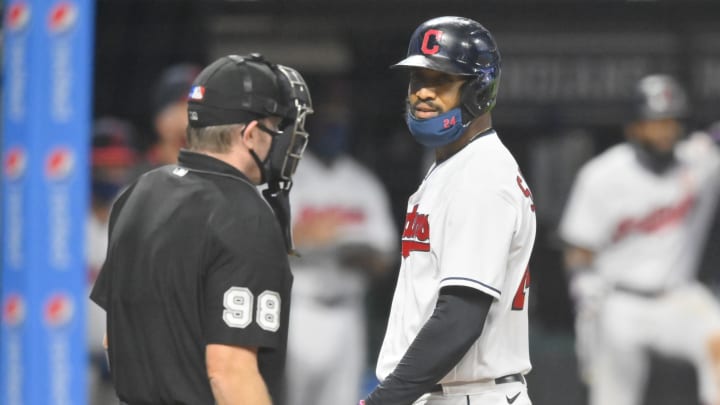Domingo Santana Was Always Facing an Uphill Battle with the Indians

Let me back up a bit, that headline is a pinch deceiving.
It certainly seemed like Domingo Santana was a perfect low risk/high reward acquisition for the Cleveland Indians, at least when the move occurred in early February.
Back then, spring training was just about to get under way. The Indians had a handful of outfield options, none spectacular, all vying for notable playing time.
It wasn’t ideal to have so many players to sift through, nor did tossing another one into the pile solve any issues. Still, with 162 games to work with, there’d be plenty of time to give everyone a decent shot while still seeing if Santana could tap into the productivity he displayed with the Brewers in 2017.
Everything went to hell soon after that.
A global pandemic put baseball on pause, eventually reducing the season length to just 60 games. The time off obviously prevented Cleveland from getting any sort of evaluation on its outfield, and the three-week summer camp hardly offered enough opportunities to accomplish much.
So, Santana basically found himself thrust into a no-win situation, attempting to stand out while receiving unbalanced playing time during a condensed campaign. He was always facing an uphill battle in Cleveland, a point hammered home when he was DFA’d Monday afternoon.
Maybe things work out differently for Santana under a 162-game season.
Though he had been struggling to replicate his 2017 numbers (.875 OPS, 127 wRC+), he was showing progress with Seattle last year before an elbow injury sapped his offensive output. Cleveland signing him to a one-year, $1.5 million deal could’ve been a steal if he was able to regain his stride.
Unfortunately, due to circumstances both in and out of the Indians’ control, he was never really given much of a chance to do so.
This isn’t to imply Santana was tearing the cover off the ball this year. He wasn’t. His wOBA (.271) and wRC+ (63) were both below average, and his issues with the whiffs came with him to Cleveland (29.8% strikeout rate).
Still, his playing time was inconsistent throughout his short stint with the Tribe. In fact, he leaves the team having played just once since August 25.
As mentioned, some of this was out of his hands. In reality, 60 games isn’t nearly enough to make conclusive judgements on any player, let alone one attempting to catch on with his third team in three years. Unless he came out of the gate guns blazing, Santana was always going to have the chips stacked against him in 2020.
That said, Cleveland’s constant outfield rotation certainly didn’t help matters, either.
A shortened season did little to dissuade the Indians from getting a look at every available outfielder this summer. To date, ten different players have logged outfield innings for Cleveland this year, including utility infielder Mike Freeman. Seven of them have seen at least 25 plate appearances.
Sure, nobody was truly standing out. Tyler Naquin remains the most productive player of the group by a mile, despite the fact his season began on August 11.
At the same time, it’s difficult to find your groove offensively if your playing time tends to be sporadic.
Was this the explanation for Santana’s struggles? Not completely. Though the sample size wasn’t huge, he wasn’t making much quality contact, to the point where his exit velocity (85.5), hard hit rate (33.3%) and barrel rate (6.7%) were the lowest of his career.
Yet, it's still not crazy to claim infrequent plate appearances played a hand in his inability to develop a rhythm.
Santana’s stay with Cleveland likely wasn’t going to be long to begin with. The bulk of his contract was back-loaded into a $5 million option the Indians were almost certain to decline.
Still, both he and Cleveland likely hoped his time with the team would’ve been more successful.
Unfortunately, he was never going to get much of a chance to change that. Cleveland had too many outfielders to parse through, and not enough time to do so effectively.
As a result, Santana found himself on the chopping block after playing just 24 games with the Tribe. It’s not ideal, but considering the circumstances he was forced to work with, it’s hardly a surprising outcome.
